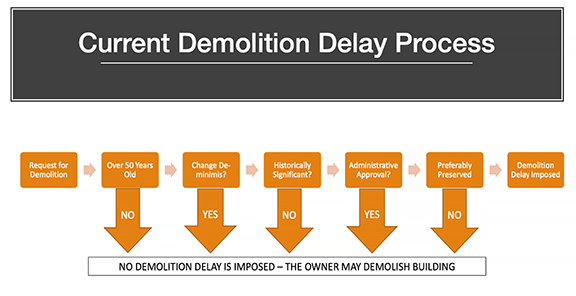
Issue summary
In 2019, a City Council working group was formed to review and revise the Landmark and Demolition Delay Ordinances. The group consisted of three Councilors from the Zoning and Planning (ZAP) Committee - Susan Albright, Deborah Crossley, Lisle Baker and one member, Andrea Kelley from the Land Use Committee. Doug Cornelius, the current Chair of the Newton Historical Committee, was also a member of the group. The group met privately and meeting minutes were not provided to the public. The Working Group presented proposed Ordinance language revisions through city staff at ZAP subcommittee meetings.
A public hearing was held on Monday April 12 - 7pm to solicit comment from the public. The public hearing was held opened.
On Monday June 28th, the ZAP subcommittee will continue to take public comment and deliberate on the proposed revisions.
A tentative date for a vote of the ZAP subcommittee is Monday, July 26th. Once this occurs, it will move on to the full Council for a final vote and adoption.
Issue full description
A powerpoint presentation detailing the proposed language revisions of Newton's Demolition Delay Ordinance is in the Document Archive of this issue (to the right). It is entitled Proposed Revisions to Newton's Demolition Delay Ordinance pptx This presentation was given at the Waban Area Council meeting on Thursday, March 11th.
For a quick FAQ flyer, please refer to the first document in the Document Archive entitled Demo Delay FAQ.
_____________________________________________________________________
What is the overall purpose of delaying the demolition of existing buildings and structures ?
The intent of a demolition delay is to provide time to seek alternative preservation solutions for historically significant buildings or structures. Possible alternatives include the alteration and/or reuse of an existing building or structure through a renovation or addition project, or its relocation to another site.
Current Demolition Delay Ordinance Intent and purpose
Newton Zoning Ordinance
DIVISION 2. DEMOLITION DELAY
Sec. 22-50. Demolition of historically significant buildings or structures.
(a) Intent and Purposes. This section is adopted in furtherance of the policy set forth in the Newton Comprehensive Plan to assure the preservation and enhancement of the City of Newton's historical and cultural heritage by preserving, rehabilitating or restoring whenever possible, buildings or structures which have distinctive architectural features or historical associations that contribute to the historic fabric of the City.
Current Demolition Delay process:
The historic review of a property is triggered when a building or demolition permit application is sought for a building or structure older than 50 years of age. A Preservation Staff member determines if the building or structure proposed for demolition or alteration is historically significant and if the Newton Historical Commission should review it. Most partial demolition are reviewed and approved by preservation staff, if it is deemed appropriate.
______________________________________________________________________________
A demolition delay consideration is a process in which each step is sequentially addressed and resolved before proceeding on to the next step in the process. The process continues until a determination standard or criteria is not met.
Once this occurs, the consideration ends and the subject building or structure drops out of the process and becomes eligible for demolition.

The AGE of a building or structure and/or its HISTORICAL STATUS determines whether or not a building or structure is eligible for a consideration of Historical Significance.
_____________________________________________________________________________________
Proposed Revisions
Substantive changes to the Demolition Delay Ordinance proposed by the Working Group.
Age of structure
Currently, there is a 50-year threshold or rolling look-back date for a property to be eligible for historic review. What is being proposed is a fixed date of 1945. The Newton Historical Commission unanimously voted (5-0-1) at their January 21, 2021 meeting against this proposed revision. Their letter to the Zoning and Planning Committee (Newton Historical Commission Letter to ZAP_012821) and can be found in the Document Archive.
Questions?
What are the implications for the change in Age of a building or structure, currently a 50-year lookback to a fixed date of 1945?
The utilization of a fixed date of 1945 would mean that any building or structure built after 1945 would not be subject to the Demolition Delay Ordinance, unless it has been surveyed and is on the MACRIS database. The MAP entitled (Map_CON_Builds_1946 - 1971 not on Macris)- in Document Archive locates Newton's housing stock that was built between 1945 -1971. In reviewing the MAP, it becomes apparent where these building and structures are located, and which neighborhoods and streets would be impacted by the proposed revision to a fixed date of 1945. Most of our housing stock built post-1945 has not received the benefit of a historic review, and would be the most impacted by this revision to the Demolition Delay Ordinance. The demolition of this housing stock would be allowed to proceed through an Administrative Approval process. This process has no requirement of public notice, abutter notification or a public hearing.
Exactly how many Newton properties in the 1946 - 2019 time period would be subject to the Demolition Delay?
Of the approximate 7100# buildings and structures that were built in the (1946 - 2019) time-period - - approximately 1260# (18%) are on the MACRIS database. The remaining 5840# (~82%) have not been surveyed and therefore not in the MACRIS database. Please review the MAP (Map_CON_Builds_1946 - Present Day not on Macris) in the Document Archive to see which neighborhood and streets would be impacted by this proposed change.
If the fixed 1945 date is utilized, then ~5840# buildings (~82% of the total # of buildings built between 1946 -2019) or 26% of our housing stock would not be subject to the demolition delay ordinance and would not be eligible for historic review. If a demolition request was filed, the demolition would be administratively-approved by planning staff and there would be no opportunity for public input.
Comparison of the current 50 years threshold to the proposed fixed date of 1945 (How many properties would be effected)?
Narrowing the time frame to (1945 - 1970) - 4400# buildings were constructed and approximately 1200# (27%) have been surveyed for historical significance. The remaining 3200# (~73% of the buildings built between 1945 -1970) have not been surveyed.
The approximate 3200# buildings built between (1945 - 1970) would not be subject to the demolition delay ordinance and would be administratively-approved for demolition.
To interpret which buildings and structures would be affected, please review the MAP entitled - Map_CON_Builds_1946-1971 not on Macris (also listed in the Document Archive to the right).
|
DATE of Construction (Year Range) |
Numbers of Buildings (% of Total Buildings) |
Properties surveyed and on MACRIS (% surveyed in Date Range) |
Numbers of Buildings (unsurveyed) (% of Total) |
|
|
|
|
|
|
1946 - 2019 |
7,100 (32%) |
1,260 (18%) |
5,840 (82%) |
|
1945 – 1970 |
4,400 (20%) |
1,200 (27%) |
3,200 (73%) |
|
Total Buildings |
22,387 (100%) |
7,118 (32%) |
15,269 (68%) |
Source: Planning Department Memorandum - 041221
New criteria standards added for a Historically Significant determination
A higher historical standard has been added to the criteria for a Historically Significant determination.
Here are some of the proposed revisions (new language in red).
A property needs to be individually listed on the National Register or formally listed as eligible for such listing on said National Register, individually
New "guiding" criteria standards for a Preferably Preserved determination
When the Newton Historical Commission is determining whether or not a historically significant building or structure is deemed to be “Preferably Preserved” there are proposed new guiding criteria for a "Preferably Preserved" finding.
Sec. 22-54 (f)
(f) If the commission finds that the demolition proposed in the application would result in the demolition of a historically significant building or structure whose loss would be detrimental to the historical or architectural heritage or resources of the City of Newton, then the commission shall find that the building or structure should be preferably preserved. In making such finding, the commission shall consider the following conditions:
1) the historic value and significance of the building or structure;
2) the architectural value and significance of the building or structure;
3) the general design, arrangement, texture and materials of the features and the relation to those features to similar buildings and structures in the nearby area; and
4) the extent of historic fabric remaining in the building or structure.
Waiver Revisions
For a partial demoliton an owner of a Preferably Preserved building or structure can seek a waiver the same night of a Preferably Preserved determination. The property is bound by the conditions issued by the Newton Historical Commission.
For a full demolition an owner of a Preferably Preserved building or structure can seek a waiver 30 days after a Preferably Preserved determination. The Newton Historical Commission can issue a finding to waive the demolition delay time period by a 2/3 vote, if the application is either 1) proposes substantial changes or 2) preserves the building or structure.
Judicial Review
There is a proposed revision for an owner of a building or structure that has been determined to be Preferably Preserved to have the right to appeal the determination to the superior court within 20 days of its issuance.
A Powerpoint presentation of the proposed revisions to the Demolition Delay Ordinance was given by Attorney Lee at the Zoning and Planning Committee meeting on February 22, 2021. It can be viewed at this vimeo link.
_______________________________________________________________
There are many regional factors that exert significant redevelopment pressure for the City of Newton. We, the current residents, are the stewards of our historic assets for Newton's future generations. It is important to appreciate the value and long-term benefit in maintaining and repurposing our existing housing stock, through adaptive reuse with retrofitted energy systems. These actions will help us narrow the gap and get closer to fulfilling Newton's Climate Action Goal of a carbon-neutrality by 2050.
The act of demolishing existing buildings and structures is known to be extremely environmentally costly, and with the concurrent site redevelopment (grade changes and tree canopy loss), as well as the additional environmental cost of embedded carbon in new construction - the environmental cost summation is a significant negative impact for the environment.